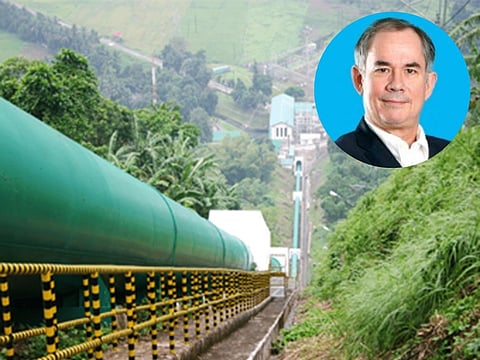Water power gold rush: Filipino tycoon Aboitiz wins $642-million CBK hydro-electric deal, what it means
Philippines hydro-electric push: Filipino tycoons power the next energy wave

Manila: Leading business tycoons here are charging into the energy sector, with the intensity of a high-stakes gold rush.
But this time, the prize is green power.
The ultimate goal: Cut dependence on fossil fuels (currently at 60% + of power generation) and (potentially) bring electricity rates down by harnessing renewables.
Is it doable?
Several Filipino billionaires sure think so — and they’re putting their money where their mouth is.
They're cracking open their vaults and shaking hands on mega deals to bankroll bold, big-ticket projects. When tycoons team up, you know something huge is cooking.
Result: An unprecedented shift into mega renewable projects, with pumped storage hydroelectric power (PSHP) as the centrepiece.
Crown jewel
At the heart of this seismic move is billionaire Sabin Aboitiz, whose consortium just clinched the crown jewel: the 796-megawatt (MW) Caliraya-Botocan-Kalayaan (CBK) PSHP, which feeds off the Sierra Madre and Banahaw mountains east of Manila.
The Caliraya hydroelectric power plant was first commissioned in 1942; the much bigger CBK complex became operational in 1983 and is also Southeast Asia’s oldest – and largest – pumped-storage hydropower facility.
The Aboitiz-led consortium, known as the Thunder Consortium, has bagged the build-repair-operate-maintain-transfer (BROMT) 25-year concession with the Department of Energy (DoE).
Their winning bid of ₱36.27 billion ($642 million) – nearly doubles the offer from their main competitor, the Lopez-backed First Gen group.
The Aboitiz consortium includes Aboitiz Renewables, Inc., Japan’s Sumitomo Corp, and Electric Power Development Co., combining local expertise with international partners.
Redrawing energy map
It doesn’t just make headlnes — it redraws the energy map of Luzon, the main Philippine island with 64 million inhabitants and a land area equivalent in size to the Netherlands, Belgium and Switzerland put together.
CBK currently accounts for only 4% of the energy for the Luzon island (where Manila is) power grid.
It’s just the beginning. More CBK-like projects are coming up.
Energy revolution
What’s behind this charge?
The first: legal reforms, specifically the enactment of RA 11966 in 2023 (“An Act providing for the public-partnership code).
The game is changing — and the power players know it. This isn’t just business. It’s part of a high-voltage transformation towards the nation’s energy security.
The second: brute-force competition.
The local tycoons are racing to be first to flip the switch, potentially driving the country on the brink of a full-blown energy revolution, driven not by oil or coal, but by water – and raw ambition.
For example, “Pakil” (1,400 MW) and “Wawa” (600 MW) PSHP projects, both under Prime Infra (led by ports barron Enrique Razon Jr.), would eventually dwarf CBK, and will be among the largest in Asia.
The two have been designated as projects of national significance, with government “green lane” endorsements to fast-track development and harness the abundance of the country's water resources.
San Miguel Global Power (led by Ramon Ang, as the country’s infrastructure king) is advancing the San Roque projects, each with 800 MW capacity, to address grid balancing and renewable integration needs.
Another PSHP, the Kalayaan expansion, is set to further boost the Luzon grid, with operations targeted for 2031.
And bigger than Wawa is the 2,000-MW Maton set in Apayao Province which has already been approved by the government alongside Pakil and Wawa.
Projects under development, planned
All told, there are an estimated 7,205 MW in pumped-storage hydropower capacity under construction/permitting stages.
The concession of CBK, a 42-year-old facility, marks a major milestone in the country’s ongoing privatisation programme of power assets.
For Aboitiz Power, it further bolsters its position as a leading hydropower player in the Philippines.
Significance
This acquisition is significant:
It secures a large, strategic renewable energy asset that supports the country’s clean energy transition goals.
It demonstrates strong investor confidence in hydropower’s role in the Philippines’ energy mix.
It ensures continued operation and rehabilitation of aging infrastructure under a 25-year BROMT contract, preserving long-term energy reliability.
Boom in hydro projects
The recent boom in hydro projects, specifically PSHP, is more than just big business — it’s a bold signal that the future of energy here is getting smarter, greener, and more resilient.
These billion-peso bets are key to unlocking the full potential of renewable sources like solar and wind, which need flexible, large-scale storage to keep the lights on even when the sun sets or the wind dies down.
In theory, solar and wind can work alongside PSHP, similar to what Dubai is doing in Hatta, the first such facility in Arabia.
Think of pumped hydro as the giant rechargeable battery the nation needs — storing excess energy when demand is low, and releasing it when everyone cranks up their aircon or logs in for Netflix night.
It’s also a critical puzzle piece in weaning the country off coal and other fossil fuels, making the grid cleaner and more stable at the same time.
TL;DR
While the Philippines has one of the most expensive electricity rates in the region, the CBK deal underscores the strategic importance of an abundant, but hugely untapped hydropower resources to bolster the country’s energy security.
The Aboitiz group’s successful bid highlights the pivotal role a growing number of energy elite play in advancing renewable energy infrastructure, harnessing nature’s blessings on these tropical islands.
Sign up for the Daily Briefing
Get the latest news and updates straight to your inbox







